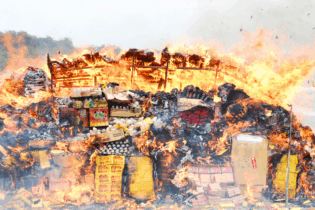Fires at landfill sites happen more often than you think, and no landfill goes unscathed. There have already been several landfill fires this year in South Africa alone.
There are several contributing factors which can lead to fires, but whether as a result of arson or the exposure of materials on site, the huge potential impact can largely be avoided with the implementation of adequate preventative measures. It’s how these fires are managed and the extinguishing process applied which will determine the extent of the damage. The effects of incorrectly handled fires are not limited to health and the environment but impact on society and business too. In some cases, nearby highways, schools and businesses have had to close. But on an effectively managed landfill a fire will be controlled quickly and limited damage suffered. Landfill fires sometimes lead to local residents being advised to stay indoors for health reasons. In the case of a landfill fire in Pietermaritzburg earlier this year those living close to the site and in ill health were asked to evacuate their homes; the same fire also resulted in the temporary closure of a nearby provincial highway. An air quality report released following the fire revealed that high levels of cancer-causing chemicals were present in the air even four days after the fire was extinguished. “This incident should serve as a case study example for operators in the waste management sector of what the potential effects of a fire could entail and what measures; such as having trained staff and other fire-fighting resources on site, should have been in place,” says Reg Gerber, National Landfill Manager at waste management company Averda’s Vlakfontein site. Landfill sites are an important part of the waste economy in South Africa, which makes the responsible management of these sites all the more important. The GreenCape 2020 Market Intelligence Report quotes government statistics which put the waste economy’s contribution to GDP in 2016 at around R24,3bn while it provided 36 000 formal jobs and support for 80 000 informal jobs and livelihoods. “We all have a part to play in the protection of these sites, the people that work on it and the communities that live in surrounding areas. It starts with paying close attention to what we send to a landfill site – for example, the reckless dumping of hot ash or coals as part of our products sent to a landfill site can lead to a fire,” says Gerber. The warmer summer weather and endless sunshine also bring with it the risk of flames being sparked by broken glass shards which act as magnifying glasses. The same warm and dry weather can also create an atmosphere in which the reckless dumping of a mixture of chemicals could lead to spontaneous combustion.“I urge businesses and members of the public to pay extreme caution when disposing of chemicals and never to include them as part of normal domestic refuse. They need to be disposed of in a legally regulated manner which eliminates the potential of fires that can cause pollution and environmental damage,” says Gerber.
There are clear regulations in place, he adds, which determine the preventative measures that have to be in place – especially when it comes to the potential danger of landfill fires. “A well-run site will ensure that daily cover up is done, to ensure that no refuse is left exposed to the elements and to potential risk of fire or combustion. Our staff working on site have access to large stockpiles of soil or to water in order to help smother any fires. Well-run sites should have trained firefighters as part of their teams to ensure a quick, on-site response. It boils down to proper preparation being done.” But what are the potential effects of a fire when it breaks out on a landfill site? This depends very much on the type of materials being disposed of as well as the size of the fire. “It is important to douse any fire as fast as is possible, before it gets out of control. On landfill sites, it could potentially burn down into the ground which has the effect of creating deep caverns of burning material. It destabilises the top-soil and we have seen examples where the ground caves in and equipment can fall into the cavern,” says Gerber. The presence of chemicals or even burning tyres could contribute to air pollution, which could be harmful to staff and pickers on site as well as to neighbouring communities. But perhaps the biggest potential area of concern is the damage that fires can have on liners. They are critical parts of any landfill site which help prevent any pollutants from seeping into ground water networks. If a fire is able to damage or destroy the liner, the potential environmental damage could be disastrous. While the potential impact of a fire on a landfill site might seem overwhelming, it is possible to take steps to prevent it from happening in the first place. “South Africa’s environmental management legislation has very detailed plans on how to manage waste and landfill sites, and how to respond whenever a fire breaks out. My recommendation is that everyone become familiar with these regulations. If you are sending any waste to a landfill site, make sure the site is properly managed and regularly audited. We all have a part to play in preventing landfill fires,” says Gerber. Press Release by Averda







